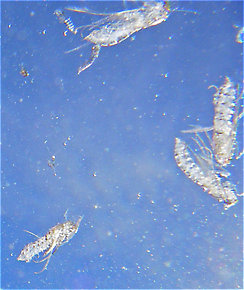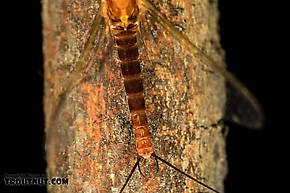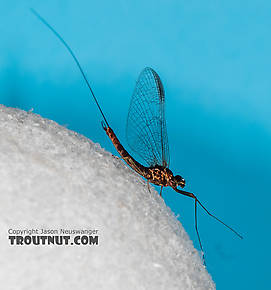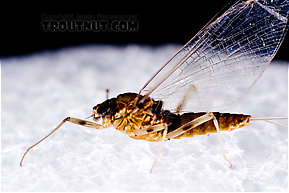Blog & Latest Updates
Fly Fishing Articles
Insects by Common Name


Mayfly Genus Rhithrogena
Taxonomic Navigation -?-
Kingdom
Animalia (Animals)
» Phylum
Arthropoda (Arthropods)
» Class
Insecta (Insects)
» Order
Ephemeroptera (Mayflies)
» Genus Rhithrogena
14 species aren't included.
The best hatches come from Rhithrogena morrisoni, Rhithrogena hageni, and Rhithrogena undulata. Even the less common species , Rhithrogena futilis, and Rhithrogena robusta are probably more important than any of their Eastern counterparts.
The East/Midwest species are Rhithrogena jejuna, Rhithrogena manifesta, and Rhithrogena impersonata, which is arguably the most important of a minor group. All of them are widespread and none of them are abundant except in rare locations, mostly in Michigan and Wisconsin.
Hatching Behavior
Most evidence points to Rhithrogena species emerging underwater. They usually do so on the stream bottom and float all the way to the surface as duns, but those emerging from slow water will rise most of the way as nymphs before struggling free of their shucks (

Here's an underwater view of the pupal shucks of several already-emerged Brachycentrus numerosus caddisflies.
Nymph Biology
Current Speed: fast to moderate
Substrate: cobble riffles, rapids, and runs
Rhithrogena nymphs are best known for their unique gills: the first and last pair of gills wrap around the bottom side of the abdomen, creating a "suction cup" which helps them cling to rocks in water even faster than other clingers can tolerate. Substrate: cobble riffles, rapids, and runs
They have been portrayed strangely in angling texts, to the extent that they are hard to recognize when first observed in the wild. Many book illustrations show the gills fully spread out and opaque, giving the nymphs an exaggerated ovoid shape. Perhaps because it's hard to draw them any other way in pencil. But this really misrepresents the actual insects; you have to look pretty closely to notice the gill extensions under the body. They are very translucent and easy to miss. In the natural state their transluscent gills are also held much closer to their bodies. These drawings also show short, robust, crab-like body shapes, perhaps to somehow emphasize their proficiency as clingers. This further exacerbates the misconception. They are great clingers, but their bodies are more narrow and streamlined than drawings indicate, as demonstrated in the photos below.
Pictures of 28 Mayfly Specimens in the Genus Rhithrogena:
Male Rhithrogena virilis Mayfly Spinner View 12 PicturesI'm fairly sure this is a specimen of Rhithrogena virilis based on closeup examination of the reproductive anatomy under the microscope (not shown in photos). The other other species of Rhithrogena this large is Rhithrogena flavianula, but the key in Needham's Biology of Mayflies mentions annulation in the abdomen (visible in some images on bugguide.net) more distinct than that on this specimen.
View 12 PicturesI'm fairly sure this is a specimen of Rhithrogena virilis based on closeup examination of the reproductive anatomy under the microscope (not shown in photos). The other other species of Rhithrogena this large is Rhithrogena flavianula, but the key in Needham's Biology of Mayflies mentions annulation in the abdomen (visible in some images on bugguide.net) more distinct than that on this specimen.
The body and front wing were both about 15.5 mm long, while the cerci (Cercus: The left and right "tails" of an insect are known as the cerci or caudal cerci. The middle tail of a three-tailed insect is not.) were 40 mm long.
 View 12 PicturesI'm fairly sure this is a specimen of Rhithrogena virilis based on closeup examination of the reproductive anatomy under the microscope (not shown in photos). The other other species of Rhithrogena this large is Rhithrogena flavianula, but the key in Needham's Biology of Mayflies mentions annulation in the abdomen (visible in some images on bugguide.net) more distinct than that on this specimen.
View 12 PicturesI'm fairly sure this is a specimen of Rhithrogena virilis based on closeup examination of the reproductive anatomy under the microscope (not shown in photos). The other other species of Rhithrogena this large is Rhithrogena flavianula, but the key in Needham's Biology of Mayflies mentions annulation in the abdomen (visible in some images on bugguide.net) more distinct than that on this specimen.The body and front wing were both about 15.5 mm long, while the cerci (Cercus: The left and right "tails" of an insect are known as the cerci or caudal cerci. The middle tail of a three-tailed insect is not.) were 40 mm long.
Collected July 5, 2017 from the South Fork Sauk River in Washington
Added to Troutnut.com by Troutnut on July 6, 2017
Added to Troutnut.com by Troutnut on July 6, 2017
Male Rhithrogena morrisoni (Western March Brown) Mayfly Spinner View 9 Pictures
View 9 Pictures
 View 9 Pictures
View 9 PicturesCollected June 22, 2017 from the South Fork Snoqualmie River in Washington
Added to Troutnut.com by Troutnut on June 23, 2017
Added to Troutnut.com by Troutnut on June 23, 2017
Female Rhithrogena Mayfly Spinner View 9 PicturesI'm very tentatively (see the connected forum thread) sticking this mayfly in Rhithrogena for now.
View 9 PicturesI'm very tentatively (see the connected forum thread) sticking this mayfly in Rhithrogena for now.
 View 9 PicturesI'm very tentatively (see the connected forum thread) sticking this mayfly in Rhithrogena for now.
View 9 PicturesI'm very tentatively (see the connected forum thread) sticking this mayfly in Rhithrogena for now.Collected June 7, 2007 from the West Branch of the Delaware River in New York
Added to Troutnut.com by Troutnut on June 8, 2007
Added to Troutnut.com by Troutnut on June 8, 2007
Recent Discussions of Rhithrogena
Clinger nymphs are shaped that way to hang in really fast currents. Really? 14 Replies »
Posted by Entoman on Feb 24, 2013
Last reply on Jun 14, 2017 by Steamntrout
It is commonly held that clingers are flattened to make their lives better adapted to faster water. Their teardrop shape is certainly a classic symbol of aero and hydrodynamic perfection, so there must be some connection, right? It seems to me that such ideas show a complete misunderstanding of the hydraulic reality in which they live. Current is negligable even in the fastest a few mm. from the surface of solid objects. In fact, it is actually quite calm. I've observed baetids clinging by their tippy toes to the tops of rocks in fast riffles with no apparent effort, often next to clinger species that look like they're hanging on for dear life. What if clinger nymphs are flattened not to hold their place in fast currents but rather to facilitate movement in their ecological niche of the cramped spaces under and between cobble or crevices in other substrate types?
It is also thought that the gills of some species form ''suction'' to hold them in place. Since suction is a phenomena of vacuum creation in the atmosphere, how are these nymphs accomplishing this underwater? Is it their ultra delicate gills that hold them in place or a firm claw grip? The horizontal sprawl of the legs masks this as the gills stay in place until the legs brake free. Exposed to the air, the gills seem to laminate against the rock, just as crepe paper would if first held underwater before a rock was lifted out into the air from underneath it. However, underwater their gills behave like the crepe, flowing freely. They are performing their function as gills not suction cups. I find it hard to believe they evolved the way some think merely so they can make it more difficult for humans to pluck them from rocks in the atmosphere. How is it these mighty structures that defy our attempts to pry them from the rocks curiously fall off so easily when prodded for inspection a few seconds later in a tray or jostled in a container on the way home?
Even many scientific papers have encouraged these dubious beliefs so it's not just angler myth... And they go unchallenged... Thoughts?
ReplyIt is also thought that the gills of some species form ''suction'' to hold them in place. Since suction is a phenomena of vacuum creation in the atmosphere, how are these nymphs accomplishing this underwater? Is it their ultra delicate gills that hold them in place or a firm claw grip? The horizontal sprawl of the legs masks this as the gills stay in place until the legs brake free. Exposed to the air, the gills seem to laminate against the rock, just as crepe paper would if first held underwater before a rock was lifted out into the air from underneath it. However, underwater their gills behave like the crepe, flowing freely. They are performing their function as gills not suction cups. I find it hard to believe they evolved the way some think merely so they can make it more difficult for humans to pluck them from rocks in the atmosphere. How is it these mighty structures that defy our attempts to pry them from the rocks curiously fall off so easily when prodded for inspection a few seconds later in a tray or jostled in a container on the way home?
Even many scientific papers have encouraged these dubious beliefs so it's not just angler myth... And they go unchallenged... Thoughts?
Your Thoughts On Rhithrogena:
Top 10 Fly Hatches
Top Gift Shop Designs
Eat mayflies.
Top Insect Specimens
Miscellaneous Sites
Troutnut.com is copyright © 2004-2024 Jason
Neuswanger (email Jason). See my FAQ for information about use of my images.
 privacy policy
privacy policy
